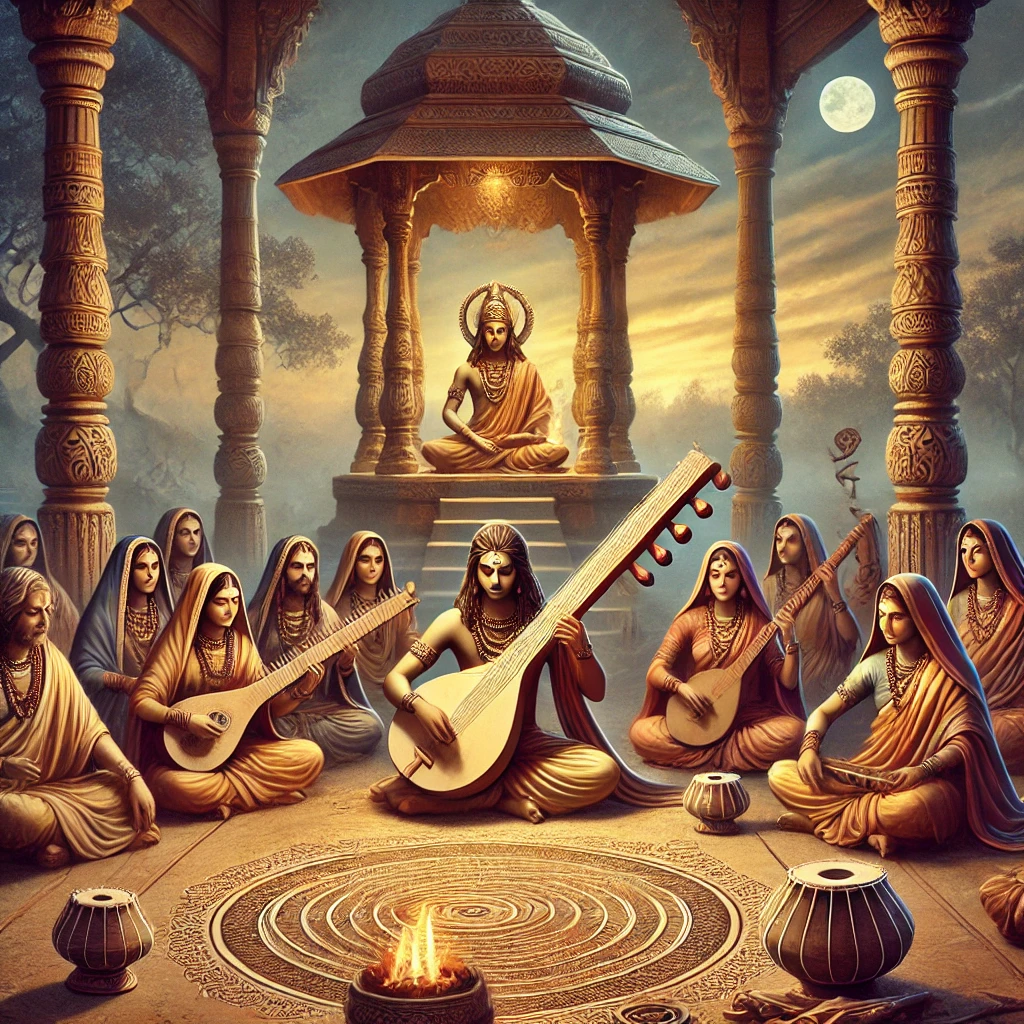
In Vedic traditions, the sāmagāyakas (singers of the Sāma Veda) often performed their hymns accompanied by the vīṇā, a stringed instrument integral to Vedic music. The Vedic scriptures mention various types of vīṇās. For instance, the Chāndogya Upaniṣad (1.7.7) states: “tadya ime vīṇāyāṃ gāyantyetaṃ te gāyanti tasmātte dhanasanayaḥ”, which translates to “Those who sing with the vīṇā, sing for Him.” This highlights the spiritual significance of the vīṇā in Vedic practices.
Let’s delve into the detail analysis of Chandogya Upanishad
स एष ये चैतस्मादर्वाञ्चो लोकास्तेषां चेष्टे मनुष्यकामानां
चेति तद्य इमे वीणायां गायन्त्येतं ते गायन्ति
तस्मात्ते धनसनयः ॥ १.७.६॥
sa eṣa ye caitasmādarvāñco lokāsteṣāṃ ceṣṭe manuṣyakāmānāṃ
ceti tadya ime vīṇāyāṃ gāyantyetaṃ te gāyanti
tasmātte dhanasanayaḥ .. 1.7.6..
The person in the eye rules the world below him and also rules the desires of the human mind. Those who sing accompanied by the vīṇā, are, in fact, singing in his honour. This is why such musicians become wealthy.
The verse from the Chandogya Upanishad (1.7.6) holds a profound spiritual and symbolic meaning, beautifully linking the inner self, human desires, music, and the pursuit of fulfillment. Let’s analyze it in detail:
Meaning of the Verse
- “The person in the eye rules the world below him and also rules the desires of the human mind”:
- The “person in the eye” symbolizes the Ātman or inner self, which is a reflection of the divine consciousness residing within every being.
- This Ātman is described as the ruler of the external world and the internal realm of desires, emphasizing the interconnectedness of the self and the universe.
- “Those who sing accompanied by the vīṇā, are, in fact, singing in his honour”:
- The act of singing with the vīṇā is elevated to an act of devotion, where the melodies pay homage to the divine Ātman.
- Music, particularly when accompanied by the vīṇā, is not merely entertainment but a spiritual offering to the divine essence that governs existence.
- “This is why such musicians become wealthy”:
- The wealth mentioned here is not limited to material prosperity but also signifies spiritual richness and the abundance that comes from being in harmony with the divine.
- Musicians who dedicate their art to the divine gain inner fulfillment, respect, and often material rewards due to the joy and peace they bring to others.
Philosophical and Symbolic Insights
- Music as a Path to the Divine:
- The vīṇā, a sacred instrument, is considered an extension of the divine voice. Singing with the vīṇā symbolizes the harmony between human creativity and cosmic order.
- Unity of Inner and Outer Worlds:
- The verse bridges the outer expressions of art and the inner spiritual journey, emphasizing that true creativity arises from a connection to the Ātman.
- Desires and Fulfillment:
- By aligning with the divine through music and devotion, one transcends mundane desires and achieves holistic fulfillment.
- Spiritual Wealth:
- The “wealth” referred to is not just material riches but also the intangible rewards of inner peace, enlightenment, and universal harmony.
Relevance in Contemporary Context
- Music as Therapy:
- The verse underscores the healing and transformative power of music, a principle echoed in modern music therapy practices.
- Art as Devotion:
- Artists who approach their craft with a sense of devotion and purpose often find their work resonates deeply, both spiritually and materially.
- Self-Realization:
- By recognizing the divine within and aligning actions (like music) with this understanding, individuals can achieve a sense of purpose and fulfillment.
This verse beautifully encapsulates the philosophy of the Chandogya Upanishad, where art, devotion, and the self converge to create a harmonious existence. It reminds us that music is not merely an art form but a spiritual practice that connects us to the divine essence within and beyond. By dedicating one’s talents to this higher purpose, one not only honors the Ātman but also enriches life with abundance, joy, and meaning.
Among the earliest vīṇās mentioned in these texts is the Ekatantrī Vīṇā (single-stringed vīṇā). This instrument was closely associated with the meditative practices of Omkāra or Praṇava upāsana. Initially, the udgātṛ (a Vedic chanter) would play the Audumbari Vīṇā, an instrument named after the udumbara (a type of tree) wood used to construct it. The chanting style involved modulating notes with ascending and descending variations to achieve desired tonal effects.
Over time, as musical traditions evolved, newer types of vīṇās were developed. These included:
- Dvitantṛī Vīṇā: A two-stringed vīṇā.
- Tritantṛī Vīṇā: A three-stringed vīṇā.
- Catuṣtantṛī Vīṇā: A four-stringed vīṇā.
- Pañcatantṛī or Citrā Vīṇā: A five-stringed vīṇā with greater melodic range.
For entertainment and social enjoyment, the number of strings in these instruments gradually increased, leading to the creation of the Śatatantṛī (hundred-stringed vīṇā) or Kautrayāyī Vīṇā. In addition to these, other forms like the Vipañcī Vīṇā (21-stringed) and the Mata Kokila vīṇā were introduced for specific musical styles.
The evolution of the vīṇā bifurcated into two primary categories:
- Vedic Vīṇās: Instruments like the Catuṣtantṛī and Citrā were used primarily for singing Vedic hymns and chants.
- Secular or Loka Vīṇās: Instruments with more strings were designed for entertainment and non-religious music.
These vīṇās lacked frets, and their simplicity allowed for intricate tonal modulations, making them ideal for Vedic chanting. Alongside the vīṇā, other instruments used in Vedic rituals included:
- Veṇu: A type of bamboo flute.
- Mṛdaṅga: A barrel-shaped drum.
- Paṇava: A small percussion instrument.
- Puṣkara: Hand drums.
- Bhāṇḍa: Cymbals or other resonant percussion instruments.
These instruments were used as needed, complementing the recitation of sacred hymns. The gradual evolution of these instruments and their applications laid the foundation for modern Indian classical music, connecting ancient traditions with contemporary art forms.
Kanchi Kamakoti Peetam Astana Vidwan
Vidwan Prashanth Iyengar

Leave a Reply